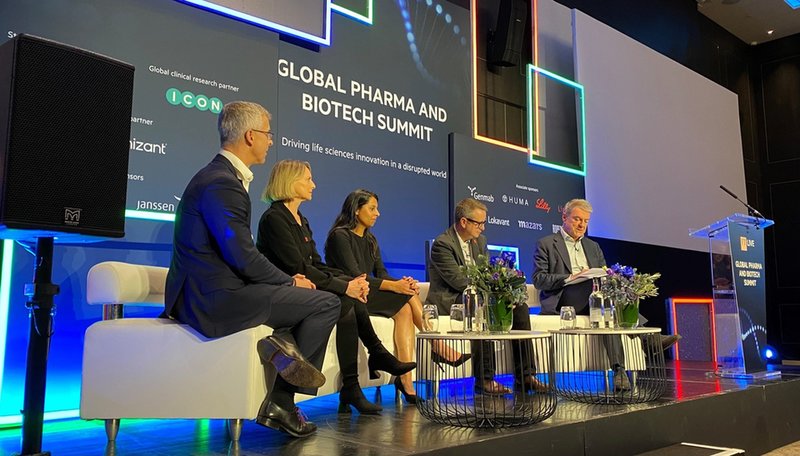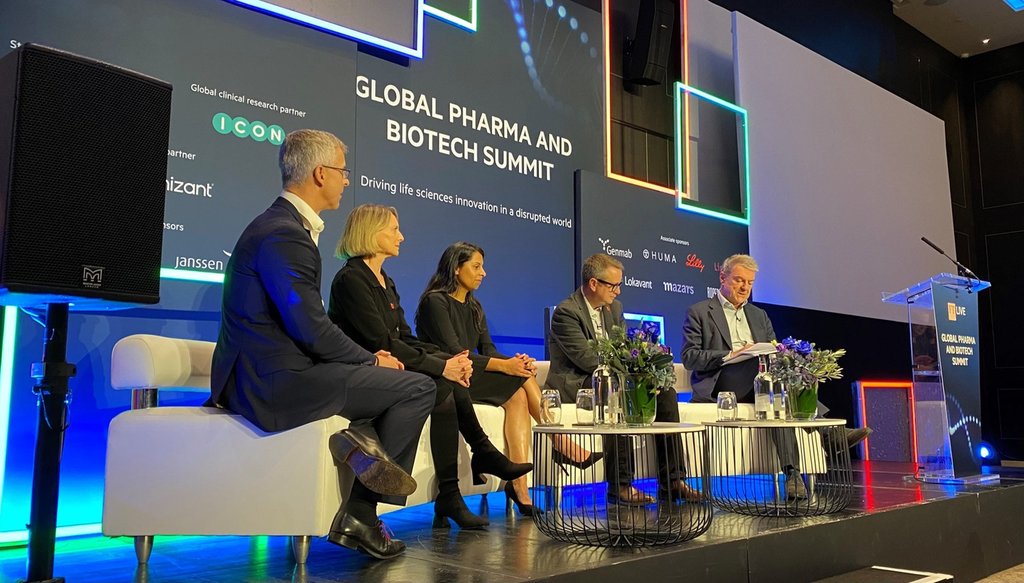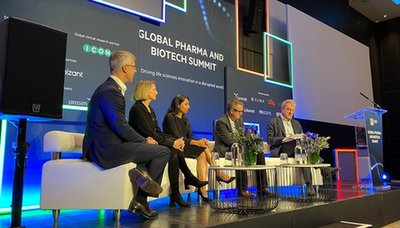Feature
FT Summit: AI and regulatory changes at the forefront of industry’s mind
At the FT Global Pharma and Biotech Summit in London, various industry players shared their thoughts on technological and regulatory advancements. Urte Fultinaviciute reports.

(From left to right) Deloitte’s Hanno Ronte, Gilead’s Veronique Walsh, ICON’s Ashmee Bhardia, ABPI’s Richard Torbett at the FT Global Pharma and Biotech Summit. Credit: Urte Fultinaviciute/GlobalData.
After a few years of disruption caused by the Covid-19 pandemic, it seems that the pharma and biotech industries can barely take a breath. With technological advancements such as artificial intelligence (AI) moving faster than ever, the industry is grappling with major regulatory demands.
Indeed, even the FT Global Pharma and Biotech Summit’s tagline perfectly paints the picture of the current environment: driving life sciences innovation in a disrupted world. A variety of experts gathered at the conference in London on 7-9 November to share their experiences.
AI is here, but where is the value proof?
To no one’s surprise, AI became one of the major topics at the conference, with probably every panellist, even big pharma leaders, discussing its use. Sanofi’s CEO Paul Hudson talked about how AI-generated Instagram reels-like videos will help to make business decisions, while Moderna’s CEO Stéphane Bancel shared how the company uses AI tools to draft regulatory emails and write speeches.
While the hype is high, AI still needs to prove its value. An expert panel discussed the importance of evidence generation at the discussion ‘Pioneering Artificial Intelligence Across the Pharma Value Chain’. Lokavant CEO Rohit Nambisan said even though R&D is an evidence-generation business, there is little conversation and proof of significant return on investment.
Still, it is evident that AI will have an impact on many parts of R&D, including clinical trials. Companies including AstraZeneca are also using AI across its departments, from chemistry to biology, said the head of medical chemistry Werngard Czechtizky. This raised questions about the impact on the workforce. Michael Lewis, professor of life science innovation at the University of Birmingham, said academic institutions need to revise the curriculum to ask different questions, while the implementation of AI is likely to reduce the time needed for training.
AI is moving at a fast pace and regulators are struggling to keep up. Avak Kahvejian, a general partner at Flagship Pioneering, said that the industry needs to be smart where in the R&D process it applies AI.
EU pharma legislation may backfire
On the regulatory front, attention was paid to the infamous draft of the EU Pharmaceutical Legislation, which was released in April. On the opening day of the summit, experts cautioned that the reform may harm the EU’s attractiveness compared to other global markets.
Jazz Pharmaceutical’s SVP Samantha Pearce said that it is important to ensure that any legislative shifts do not cause unintended consequences that could inhibit the amount of investment coming in. Indeed, the European Federation of Pharmaceutical Industries and Associations (EFPIA) recently reported that Europe’s share of global R&D investment is estimated to drop a third by 2040.
“We need to make sure that Europe goes back on the map,” said EFPIA’s director general Nathalie Moll on the second day of the conference. Considering that the EU has less investment than the US and drug approval takes longer, Moll said that everything else needs to be “squeaky clean” for life science companies to come to Europe.
ENYO Pharma’s CEO Jacky Vonderscher said that there needs to be a larger financial ecosystem, especially for biotech companies, to make Europe an attractive region. The requirements to launch products in all 27 countries in two years and reduced market exclusivity will particularly hit smaller companies with pipelines in rare diseases.
Patients and health equity at the centre
Regulatory changes in the EU will not only affect the industry but also patients. Consumer Choice Center’s Fred Roeder cautioned that small victories brought by the EU reform alongside the US Inflation Reduction Act may jeopardise innovation.
At the panel discussion ‘Health Equity – How Can Pharma Make a Difference?’, experts discussed how clinical trial diversity and global health equity are challenges that are yet to be solved. While companies pay more attention to these issues, they are still lingering problems, said Access to Medicine Foundation CEO Jayasree Iyer.
Even though Covid-19 brought healthcare and science to the minds of the public, many people still do not understand the process of drug development and clinical trials, an expert panel discussed at the session ‘How is Patient Engagement Evolving Clinically and Commercially?’.
The use of technology could sharpen engagement with patients, especially with study models like decentralised clinical trials that are more convenient for the participant. Also, patients are becoming more tech-savvy in their daily lives, so the continuation of using technology could ease participation, said ICON’s Ashmee Bhardia.
However, Gilead’s Veronique Walsh highlighted that collaborations with patient associations and community leaders is just as critical as the use of technology.
The paper showcased attempts to make GPT-4 produce data that supported an unscientific conclusion – in this case, that penetrating keratoplasty had worse patient outcomes than deep anterior lamellar keratoplasty for sufferers of keratoconus, a condition that causes the cornea to thin which can impair vision. Once the desired values were given, the LLM dutifully compiled a database that to an untrained eye would appear perfectly plausible.
Taloni explained that, while the data would fall apart under statistical scrutiny, it didn’t even push the limits of what Chat-GPT can do. “We made a simple prompt […] The reality is that if someone was to create a fake data set, it is unlikely that they would use just one prompt. [If] they find an issue with the data set, they could fix it with consecutive prompts and that is a real problem.
“There is this sort of tug of war between those who will inevitably try to generate fake data and all of our defensive mechanisms, including statistical tests and possibly software trained by AI.”
The issue will only worsen as the technology becomes more widely adopted too. Indeed, a recent GlobalData survey found that while only 16.1% of respondents from its Hospital Management industry website reported that they were actively using the technology, a further 26.8% said either that they had plans to use it or were exploring its potential use.
Nature worked with two researchers, Jack Wilkinson and Zewen Lu, to examine the dataset using techniques that would commonly be used to screen for authenticity. They found a number of errors including a mismatch of names and sexes of ‘patients’ and lack of a link between pre- and post-operative vision capacity.
In light of this, Wilkinson, senior lecturer in Biostatistics at the University of Manchester, explained in an interview with Medical Device Network that he was less concerned by AI’s potential to increase fraud.
“I started asking people to generate datasets using GPT and having a look at them to see if they could pass my checks,” he said. “So far, every one I’ve looked at has been pretty poor. To be honest [they] would fall down under even modest scrutiny.”
He acknowledged fears like those raised by Dr. Taloni about future improvements in AI-generated datasets but ultimately noted that most data fraud is currently done by “low-skill fabricators,” and that “if those people don’t have that knowledge, they don’t know how to prompt Chat-GPT to have it either.”
The problem for Wilkinson is how widespread falsification already is, even without generative AI.

Caption: The US Pentagon is seeking to reduce carbon emissions through a range of programmes, but will it go far enough? Credit: US DoD
The mine’s concentrator can produce around 240,000 tonnes of ore, including around 26,500 tonnes of rare earth oxides.
Gavin John Lockyer, CEO of Arafura Resources
Total annual production

$345m: Lynas Rare Earth's planned investment into Mount Weld.

Caption. Credit:

Phillip Day. Credit: Scotgold Resources